FiiO X5 - the flagship among portable audio devices
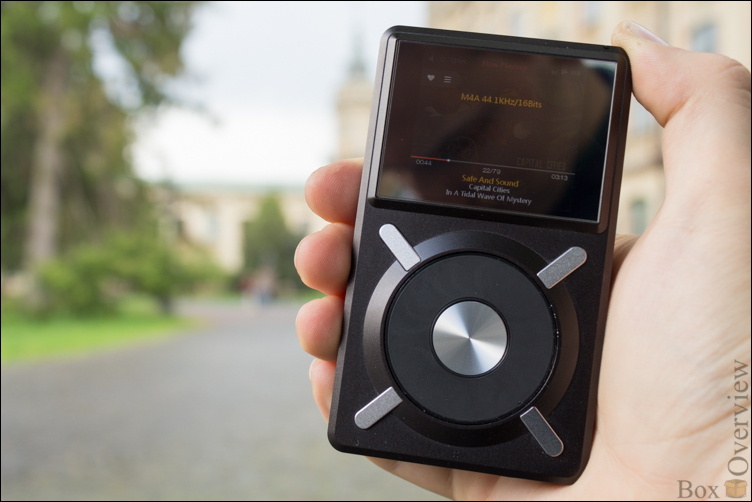
My first article on Habrahabr was a review of the FiiO E17 - a very fun and extremely niche device combining a DAC and an amplifier designed for portable use. It's funny to look at your first lines, but not about that now. I remembered the article because of comments to this, or rather just one comment:

The FiiO company apparently listened to the vvzvlad habrauser and equipped a very trivial portable DAC with its own memory, display, and new case, but it turned out that the FiiO X3 is the youngest model in the line of players of the Chinese company. And today I will talk about FiiO X5 - the flagship among portable sound reproducing devices.
► Specifications
 2.4- inch IPS display with a resolution of 400x360 pixels
2.4- inch IPS display with a resolution of 400x360 pixels 2 microSD memory card slots up to 128 GB
2 microSD memory card slots up to 128 GB Audio formats support: FLAC, ALAC, DSD, APE, APE, WAV (all up to 24 Bit / 192 kHz), WMA 9.1 LOSSLESS (24 Bit / 96 kHz) - lossless formats (lossless compression); MP2, MP3, AAC and other lossy audio compression formats are also supported.
Audio formats support: FLAC, ALAC, DSD, APE, APE, WAV (all up to 24 Bit / 192 kHz), WMA 9.1 LOSSLESS (24 Bit / 96 kHz) - lossless formats (lossless compression); MP2, MP3, AAC and other lossy audio compression formats are also supported. Output stage power 480 mW per channel at a load of 16 ohms and more than 260 mW at a load of 32 ohms
Output stage power 480 mW per channel at a load of 16 ohms and more than 260 mW at a load of 32 ohms 3700 mAh ( 10-13 hours + promise to increase autonomy in subsequent firmware)
3700 mAh ( 10-13 hours + promise to increase autonomy in subsequent firmware) Dimensions: 67.6 x 114 x 15.6 mm
Dimensions: 67.6 x 114 x 15.6 mm Weight: 195 grams
Weight: 195 gramsA complete table of specifications from the official manufacturer's website

► Packing and packaging
It would seem that the flagship product should have the appropriate packaging, but FiiO did not bother too much about this, at least it may seem that when you first met the player.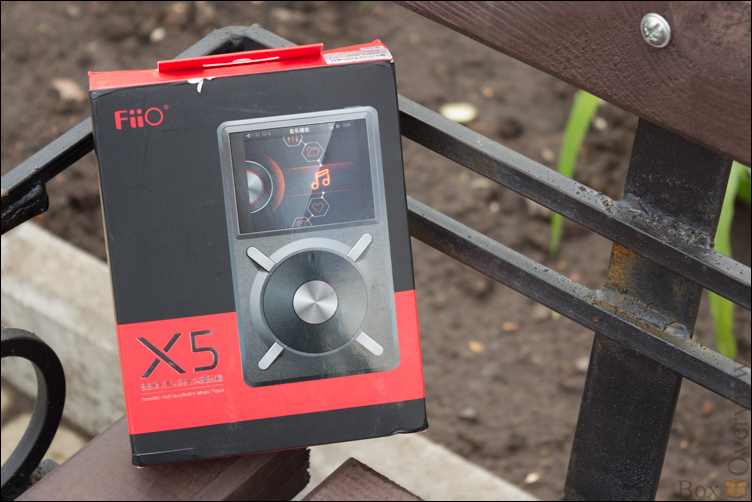
Having opened the first, unremarkable paper box we get a case from the dense textured cardboard. Inside, nothing dangles, so you can not worry about the state of the player after delivery by mail.

Step 3: open the cardboard box and see the player itself (in the complete silicone case) surrounded by a foam plastic seal for preservation during transportation. Here are the first elements of a complete set: 15% discount on music in HD quality from the HDtracks.com service and a small “Quick Start” instruction.

Go ahead and “stumble” again on the box, this time the last one. It contains all the remaining equipment, namely: 2 spare films per screen, USB-card reader for MicroSD cards, plugs for 3.5 mm ports, USB-OTG cable, adapter for coaxial output, more paper, and USB-cable, which I safely forgotten at home.

Plugs - absolutely awesome thing. And why only smartphone manufacturers do not put these in the package? Conveniently, especially if your smartphone does not have moisture protection.

Completion and good packaging still pleasing to the eye. On the other hand, a player of such a price category is simply obliged to possess high-quality packaging and an extensive package. About the power supply, in my opinion, it is already useless to remember, the company delivers all its products without it, but this fact does not remove responsibility from it. Taking into account the battery capacity, charging from USB can be delayed for a good 6-7 hours.
► Appearance, controls
Designers (designer?) Chinese company did not reinvent the wheel and left a strict, brutal appearance, which is inherent in most FiiO products. Aluminum dominates the hull materials, positioned by the company as aviation. The player is sold only in black.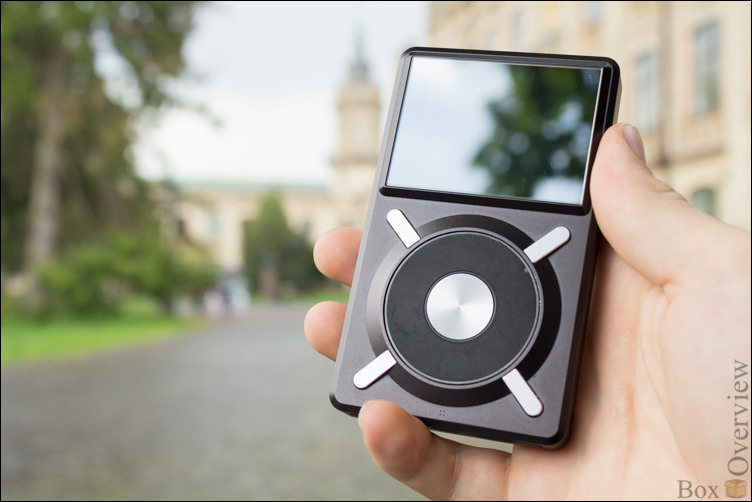
On the front side, in addition to the display, control wheel and 5 keys (4 around the circumference and one in the center of the wheel) there is a small LED indicator that indicates the device is charging. Buttons, unfortunately, are deprived of marking, so you have to immediately remember their purpose.

The control wheel, the prototype of which clearly served more than one generation of iPods, was very well implemented in FiiO. Not only did we manage to bypass the patents of the “apple” company (I remind you that Apple had a touch wheel) and also to make it extremely convenient to use. Banal scrolling "analog" wheel soothes, believe me. ;)

Most of the connectors are concentrated on the upper edge of the case (from left to right): headphone output, linear and S / PDIF (coaxial, digital) output. Here is the power button and reset (small hole in the center).

The right side is pristine, and on the left is a volume rocker. It noticeably protrudes beyond the body, thanks to which it is easy to grope, the stroke of the buttons is short, there is no accidental pressing.

Below - two slots for memory cards covered with rubber plugs and microUSB connector for synchronization and charging. The card slots are covered, in my opinion, by unnecessarily tight plugs, since open them quite problematic.

The back cover is not removable, made of cross-brushed aluminum, while on the front panel and on the edges of the aluminum has a matte, rough texture.
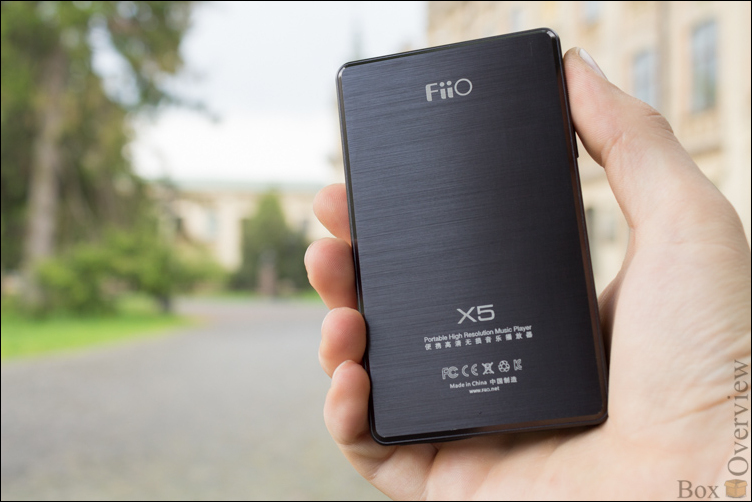
As a result, the design of the FiiO X5 personally caused only positive emotions in me, while most others may be disappointed about the “brickiness” of the device and its considerable weight. Oh yeah and the rubberized control ring just fine. :)
')
► Display, operating system and interface
The display is a mirror (primarily due to the weak brightness of the backlight) and this is bad, because the owners of such an expensive and niche thing are unlikely to admire their reflection in the FiiO X5 display? And although ... Well, okay, this is where his flaws end. On the other hand, it is an IPS matrix with a diagonal of 2.4 inches and a resolution of 400x360. Viewing angles are really great, and 224 ppi have a great effect on picture quality.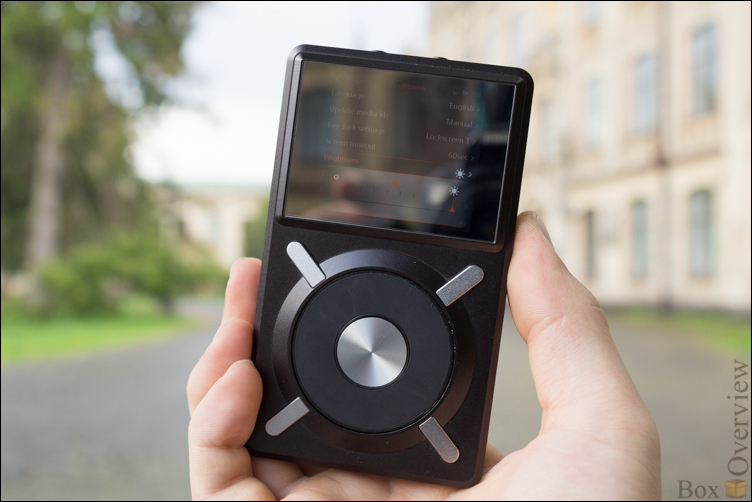
In the role of the OS, there is something "samopisny", there are no third-party applications and other things. The player turns on by pressing the Power key for a few seconds and immediately greets us with a greeting. From the moment you press it to the start of playback, it takes about 10 seconds, which is quite a lot by modern standards.
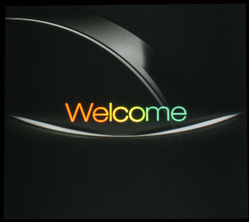
On the main screen there are 7 icons for the selection of which the control wheel and the central key or two buttons at the bottom of the device are responsible (left - back, right - forward). By default, the first icon is Now Playing (the music that is playing now). When you click on it, go to the current playlist.


Playback settings are represented by eight items. Among the standard ones, you can, for example, highlight the ability to set a threshold for maximum volume and change the gain level.

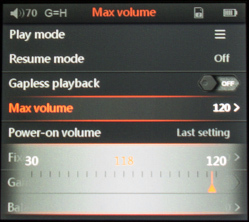

System settings are more extensive. Here you can already change the interface language (neither Russian nor Ukrainian is still there), adjust the operation of the keys when the display is off, change the display brightness and its off time.
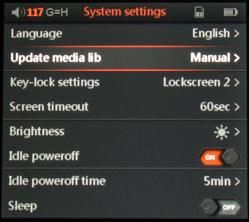

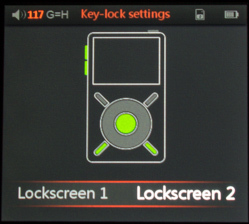
The player also has a sleep mode, in the USB mode field, you can set the player to enter the DAC mode when connected to a USB computer.
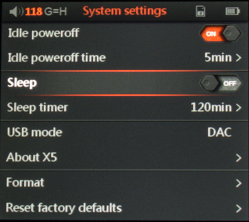
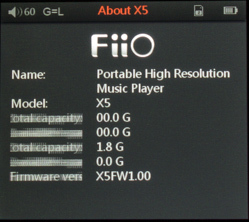

Following the location of the shortcuts in the main menu, we fall into a 10-band equalizer. A choice of 10 presets, including one manual. Next - the submenu "Favorites" in which you can collect your favorite tracks.

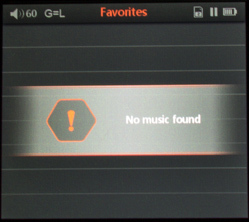
File navigation is represented by two shortcuts: “Play by category” and “Browse files”. I do not think they need a detailed explanation. I note that with the firmware update, the OTG section appeared in the general file navigation.

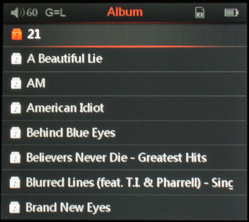
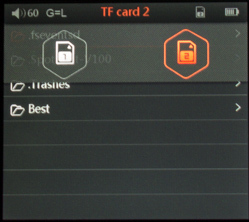
The playback screen consists of 3 main elements: the upper statustbar (volume level, amplification mode, a memory card with which music is played and battery charge), an album or track cover and a lower bar (timeline, track number, its name, artist and album) . By clicking on the button in the upper left corner, an additional menu appears in which you can add a track to your favorites or delete it at all.
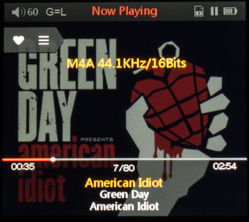

The change in volume is illustrated by a circular progress bar which can be called up by holding the central key and then changing the volume with the wheel or standard rocker on the left side of the case.

The interface, though not the most convenient, but quite simple to learn. Now FiiO is actively finishing it, new firmwares often come out, so over time I think it will be brought to full mind. Here here is a great official manual from the company itself.
Firmware
The player came to me with the firmware version 1.0, and at the time of writing, as it turned out, the second version of the OS is already available. They say it has a lot of things finished so it's time to upgrade. Further points:- We stamp on the official FiiO website and download the latest available firmware in the Support section.
- We format memory cards up to 32 GB in the FAT32 file system.
- Just in case, it is worth checking the battery charge in order not to kill the player by a sudden shutdown during the firmware.
- We unpack the pre-downloaded archive with the firmware and at the output we get the file x5.fw, which we copy to microSD .
- Turn off the player and insert the memory card in the first slot .
- Hold the key on the upper left of the control wheel, and then hold the power button.
- After the update process is completed, the player will automatically reboot, and you will only have to remove the firmware from the memory card.
From the observed innovations in firmware 2.0:
- Increased speed and overall responsiveness of the player
- In Lockscreen 1 mode, the volume key on the left side of the device now works
- Implemented USB OTG support
- Support and playback of DSD audio format
► Sound, operation, autonomy
I, as usual, have more of a review of the piece of iron than an audio player, as the sound quality gags on the Internet are already full, and I haven’t found a good overview of the device itself. Since the player has 2 main modes of operation, I decided to give them more attention.► Use as a player
To carry such a brick in your pocket for the sake of listening to music will be only an ardent music lover. Yes, of course, I really like the piece of hardware, I like its “uncooked” design, I like its sound, the ability to cope with most good headphones and discover their true essence. But I, unfortunately, the device did not stick. If I want to listen to high-quality music, I will fall apart in a chair and indulge in a desktop source. Well, on the road there will be enough iPhone or Android-smartphone with a sane sound path.► Use as a DAC
Do not forget that the manufacturer positions the device not only as a player, but also as a digital-to-analog converter. All that is needed is to set the DAC mode in the “USB mode” field in the player menu and connect the device to a PC or Mac. In the latter, who did not know, you can quickly change the playback source by pressing Alt + speaker icon in the status bar.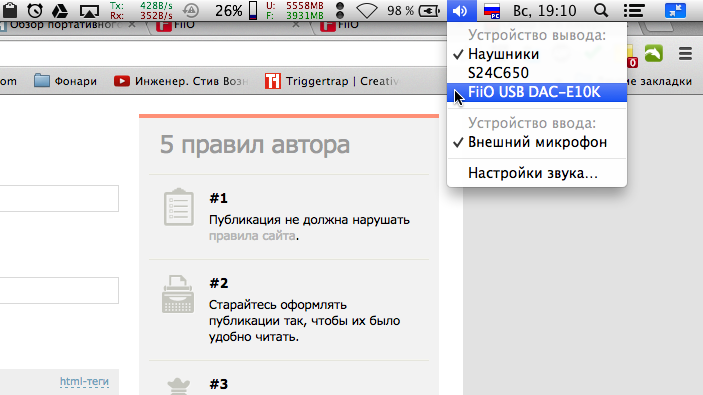
Again, sort of like 2 in 1, and it should be convenient, but not for me. As a stationary source, I’m quite content with the FiiO E10K - the updated E10 Olympus model I wrote about a year and a half ago. This little box is really from the category of Must Have, for $ 80 you can pump your musical path to a sane level. So that you are not surprised by the above conclusions, I’ll say that this time I didn’t buy this player (although I was going to) - FiiO provided me with a review considering the audience was interested in this product.
In the role of the DAC in the FiiO X5 used PCM1792 from Texas Instruments. And the whole audio path is as follows (on top of FiiO X3, and on the bottom is model X5):

The craftsmen from the forum have already managed to remove the frequency response of the player. Especially for those interested (+ link to the full document with other dimensions):
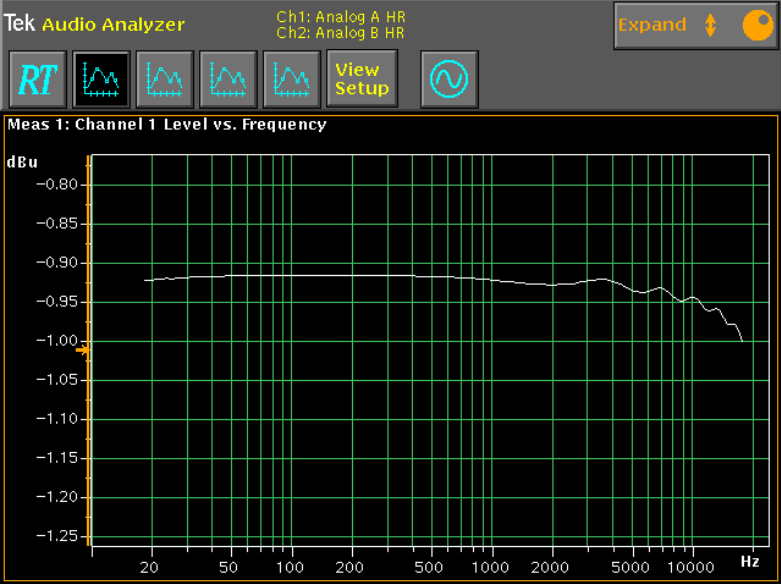
About autonomy. In the mode of continuous listening to music, the device worked on average ~ 12 hours. Charging time at 5 hours. With autonomy, everything is fine, the charge will suffice both in the case of the urban mode of use, and in the case of the near trip.
► Results
FiiO X5 - one of the best portable players at the moment. Element base, build quality and even equipment - all at the highest level. But the thing is definitely an amateur; not everyone needs such a high-quality portable source, because in order to enjoy music there is not enough just high-quality sound, the situation also plays an important role. Therefore, if you are sure of the need of this player, then feel free to buy, otherwise it is better to invest in something more useful. By the way, that’s why I didn’t count the cost as advantages or disadvantages, since it is rather adequate for other solutions.Advantages and disadvantages
 Excellent sound characteristics
Excellent sound characteristics High quality build and materials
High quality build and materials Rich equipment
Rich equipment Convenient management
Convenient management Two slots for memory cards
Two slots for memory cards Omnivorous sound formats
Omnivorous sound formats Sun display readability
Sun display readability Unlabeled buttons
Unlabeled buttons Lack of network memory in the standard package
Lack of network memory in the standard package► Cost
In the world market, the official cost of this player is $ 350, but locally it turns out to be a bit more expensive. So, in Ukraine the player will cost you 4810 hryvnia , while in Russia the price fluctuates around 15,000 rubles.► Related Links
FiiO X5 on the manufacturer's official websiteDiscussion on the forum player.ru
Hi-tech news overview
Impressions of foreign users on the forum head-fi.org (English)
I remind you that you can subscribe in order not to miss new reviews and articles
 on the company’s page (“subscribe” button), or on your favorite social network:
on the company’s page (“subscribe” button), or on your favorite social network:  Vkontakte , in
Vkontakte , in  Google + , in
Google + , in  Twitter
TwitterSource: https://habr.com/ru/post/221081/
All Articles